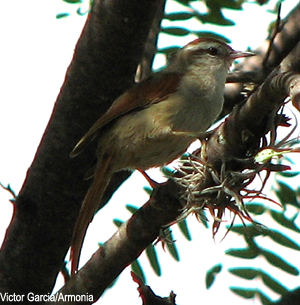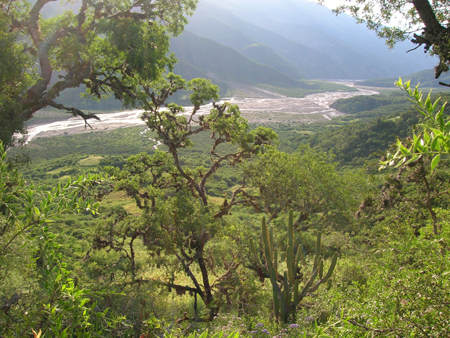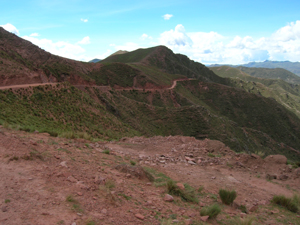Machaca
by Bennett Hennessey
 The Machaca forest is one of the
few sites in existence which protects the endemic and Endangered Bolivian
Spinetail. The Spinetail is specific to a dry forest with high plant endemism
found only in the Rio Cocapata watershed. Almost its entire habitat has been
disturbed with the only two relicts of decent forests known in the Machaca
and Inquisivi site. In Inquisivi the forest is being destroyed for
consumption in the city of La Paz Within the correct
forest habitat the Bolivian Spinetail can be easily observed foraging in the
tree tops, and through the low bushes (see bird list). Learn its distinctive song, as it
sings through-out the day. It is almost certain that a day in the habitat you
will see the species- if not phone Armonía urgently! Also look out for such
species as the Green-barred Woodpecker- which is different in the area. This
is also a good site to see the Black-and-rufous Warbling-Finch. And of course
keep an eye out for the Rufous-bellied Saltator in the fields around the village of Machaca. The Machaca forest is one of the
few sites in existence which protects the endemic and Endangered Bolivian
Spinetail. The Spinetail is specific to a dry forest with high plant endemism
found only in the Rio Cocapata watershed. Almost its entire habitat has been
disturbed with the only two relicts of decent forests known in the Machaca
and Inquisivi site. In Inquisivi the forest is being destroyed for
consumption in the city of La Paz Within the correct
forest habitat the Bolivian Spinetail can be easily observed foraging in the
tree tops, and through the low bushes (see bird list). Learn its distinctive song, as it
sings through-out the day. It is almost certain that a day in the habitat you
will see the species- if not phone Armonía urgently! Also look out for such
species as the Green-barred Woodpecker- which is different in the area. This
is also a good site to see the Black-and-rufous Warbling-Finch. And of course
keep an eye out for the Rufous-bellied Saltator in the fields around the village of Machaca.
Conservation Note: This site is an Important
Bird Area (IBA) and an Alliance
or Zero Extinction site
(AZE). Armonía is  working with the community of Machaca, to attempt to
protect this area through education, habitat restoration and community
sustainable development support. Your visit can play an important part in the
conservation of this area. Tourism will demonstrate to the community that the
forest has another value in its intact state. Armonía will be working with
the community to create tourism infrastructure so that they can earn money
from their efforts to protect the forest. But presently this does not exist.
If you want to help conservation of this truly threatened habitat, the best
thing to do would be to leave money in the village as a form of payment for
services (not as free gifts, where the final result is a begging community).
You could pay for such services as a room for the night, a dinner, someone to
guide you to the trail, renting a donkey to carry your stuff (if you are
going to camp in the forest), someone to wash your clothes, or purchasing
local handcrafts and their farm working with the community of Machaca, to attempt to
protect this area through education, habitat restoration and community
sustainable development support. Your visit can play an important part in the
conservation of this area. Tourism will demonstrate to the community that the
forest has another value in its intact state. Armonía will be working with
the community to create tourism infrastructure so that they can earn money
from their efforts to protect the forest. But presently this does not exist.
If you want to help conservation of this truly threatened habitat, the best
thing to do would be to leave money in the village as a form of payment for
services (not as free gifts, where the final result is a begging community).
You could pay for such services as a room for the night, a dinner, someone to
guide you to the trail, renting a donkey to carry your stuff (if you are
going to camp in the forest), someone to wash your clothes, or purchasing
local handcrafts and their farm  produce. Also if you really want to help the
project, you could donate to Armonia's Bolivian Spinetail Conservation
Program. produce. Also if you really want to help the
project, you could donate to Armonia's Bolivian Spinetail Conservation
Program.
Logistics: If you are renting a car,
I recommend a large four-wheel drive like a Toyota Landcruiser or a Nissan
Patrol- these larger vehicles will smooth-out the rough 6 hour dirt road
drive in (aprox. 8 hour drive from Cochabamba). From the central plaza in Cochabamba. At this toll set your odometer to
0 km.
10 km further on there is a
gas station where you should fill your tank. At the
34 km point, we saw
Bolivian Blackbirds on the roadside. Pongo is at
66 km
area). From Pongo you need to turn right after the sign to Independencia (see
photo). The dirt road you want travels between the aqua painted two story
house and Restarant Cochabamba. Set your odometer to zero again. Around
20 km, there is a type of
fork in the road, where you go to the right. At
57 km, you will come to a
road
check point, where you need to tell them that you are going to Machaca.
Travel another 4km up the road to a great high Andean restaurant called
Virgen de Guadalupe. I strongly recommend that you have a High Andean style
soup here.  Nothing to worry about, the soup is boiled- no germs. I bet you
someone in your group will have more than one. Nothing to worry about, the soup is boiled- no germs. I bet you
someone in your group will have more than one.
At
63 km you will arrive at Machaca.  Back to zero km. Continue up the road
from the plaza. 10 km
up there is a somewhat fork, where you should take the road on the left. At
16 km
You must ask for a corigidor here, to pay your entrance fee to visit the
forest. This is very important. This community is protecting the forest. The
Armonía Bolivian Spinetail conservation program wants to show them that there
is a tourism benefit from protecting the area. If they do not have a price, I
suggest 5 US$ per person per day. Here you can ask for some very humble
lodging. If you are staying in Machaca- you can also camp in the town (look
out for Rufous-bellied Saltator), pay a guide around 20 Bolivianos to show
you the trail to the forest. It is about a one hour Back to zero km. Continue up the road
from the plaza. 10 km
up there is a somewhat fork, where you should take the road on the left. At
16 km
You must ask for a corigidor here, to pay your entrance fee to visit the
forest. This is very important. This community is protecting the forest. The
Armonía Bolivian Spinetail conservation program wants to show them that there
is a tourism benefit from protecting the area. If they do not have a price, I
suggest 5 US$ per person per day. Here you can ask for some very humble
lodging. If you are staying in Machaca- you can also camp in the town (look
out for Rufous-bellied Saltator), pay a guide around 20 Bolivianos to show
you the trail to the forest. It is about a one hour  walk. You will know you
are in the forest when you come to trees with long grey beard like
bromeliads- this is the nesting material for the Bolivian Spinetail- and
possibly one of the limiting factors to its distribution. walk. You will know you
are in the forest when you come to trees with long grey beard like
bromeliads- this is the nesting material for the Bolivian Spinetail- and
possibly one of the limiting factors to its distribution.
If you want to
travel and camp near the forestand
away from the town, turn left on the first fork in the road entering the town
(see photo- go down road with jeep). At
43 kmFrom Independencia
you need to hire local transportation to Machaca. El senor Vitalio Heredia
has a store two blocks before reaching the Independencia plaza when
travelling to Machaca. He can take you and pick you up in Machaca for 400
Bolivianos round trip- but pay at the end. About a one hour drive travelling
over a mountain ridge.
Acknowledgements
 The initial
research into the site came from the Armonía volunteer work of Sophie
Lake, Durwyn Liley and Ebert Rocha.
More detailedinformation came from the Armonía program research by Monica
Beatriz San Cristobal supported by Conservation International. The initial
research into the site came from the Armonía volunteer work of Sophie
Lake, Durwyn Liley and Ebert Rocha.
More detailedinformation came from the Armonía program research by Monica
Beatriz San Cristobal supported by Conservation International.
Bird List |

